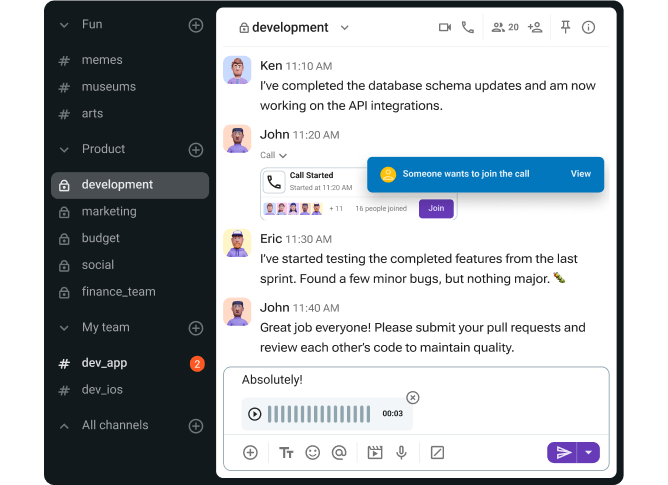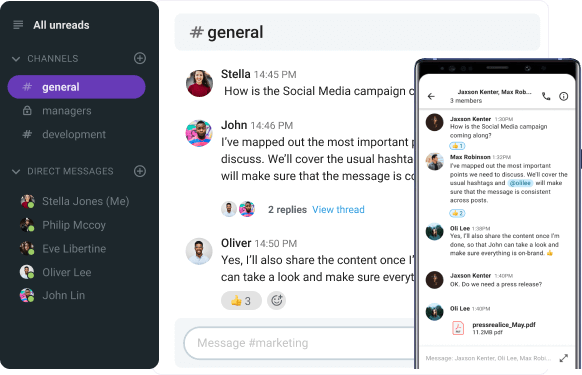If your team is already using Zoom for video meetings, you’re probably familiar with its features for calls, webinars, and client sessions.
But if you’ve tried using Zoom Team Chat for day-to-day internal discussions, you’ve probably found it falling short.
That was my impression when trying it out. I believe Zoom can be great for external catch-ups, but when it comes to internal communication, I can see it becoming fractured across emails, meetings, and random threads that disappear once the meetings end.
From the first use, I wasn’t a fan of the app’s UI, and I felt it was missing the sense of permanence of a team communication hub.
That’s why I wanted to compare it to Pumble by CAKE.com.
As someone who spent years struggling with fragmented team communication, I wanted to share how Pumble compares to Zoom and whether it might just become the organized, intuitive communication hub your team is missing.

Pumble vs Zoom: Main features comparison
Pumble and Zoom are both communication tools designed to help teams collaborate virtually, but they take very different approaches — especially when it comes to their main features and pricing.
Zoom offers great video capabilities and plenty of integrations, but much of this is limited to high-paying users.
Pumble, on the other hand, allows for structured and permanent conversations, plus it offers most of its functionality for free or within reasonably priced plans.
Some of the main differences between Pumble and Zoom include:
- Pricing — Pumble’s paid plans start at $2.49 vs Zoom’s at $13.33,
- Free plan limits — Pumble offers unlimited messaging history and 10 GB of storage; Zoom has no free storage and limits your calls to 40 minutes, and
- Approach to communication — Pumble is designed with the messaging-first workflow in mind, while Zoom’s main communication functionality is centered around video calls.
Let’s take a look at the comparison of the main features of Pumble and Zoom.
| Features | Pumble | Zoom |
|---|---|---|
| Pricing plans | – FREE plan with unlimited users and messaging history – PRO plan: $2.99 per user per month (billed monthly), or $2.49 (billed annually) – BUSINESS plan: $4.99 per user per month (billed monthly), or $3.99 (billed annually) – ENTERPISE plan: $7.99 per user per month (billed monthly), or $6.99 (billed annually) | – Free plan with limited group calls (40 minutes) and messaging history (only during an active meeting) – Pro plan: $16.99 per user per month (billed monthly), or $13.33 per user per month (billed annually) – Business plan: $21.99 per user per month (billed monthly), or $18.33 per user per month (billed annually) |
| Interface | Clean, easy to adopt, customizable themes and sidebar | Straightforward, familiar, feature-heavy, complex |
| Communication features | – Unlimited messaging history – Channels – Threads – Voice and video messages – Polling – Guest access | – Channels – Threads – DMs – Voice and video messages – Polling |
| Video conferencing | – Video is integrated into messaging workflow – 1:1 video and audio calls – Group video and audio calls – Screen sharing – Guest access to meetings | – Video-first workflow – 1:1 video and audio calls – Group video and audio calls – Screen sharing – Guest access to meetings – Multiple people spotlight – Large meetings add-on – Whiteboard – Webinars add-on |
| File sharing and storage | – 10 GB per workspace in the FREE plan – 10 GB per user in PRO – 20 GB per user in BUSINESS – 100 GB per user in ENTERPRISE | – No cloud storage in the Free plan – 10 GB per license in Pro – 10 GB per license in Business |
| Integrations | – Core apps like Gmail, GitHub, Google Calendar, Zapier – Clockify and Plaky | 3,000+ integrations |
| Support | – 24/7 support on all plans – Dedicated success representative on paid plans | – Help Center (on the free plan) – 24/7 priority support (on paid plans) |
| Security | Industry standard advanced security | Questionable security |
Now, let’s compare the main features of Pumble and Zoom in more detail to help you determine what makes more sense for your team.
Pumble vs Zoom: Pumble is more generous and less limiting
The first difference you’ll notice between the two apps is the price.
Or, better yet, the value you get in each tier.
Pumble famously offers one of the most generous free plans, including:
- Unlimited users — so you can get your entire team on board,
- Unlimited message history — if your team needs to archive any decisions and discussions,
- 10 GB storage per workspace — perfect for when you want to seamlessly share files and resources,
- Channels, threads, and search — for unlimited conversations,
- Scheduled messages and reminders — to never miss a message, and
- Free basic voice and video calls — at no extra cost.
That’s enough to run an entire small business or startup — without hitting a paywall.
In my opinion, Pumble’s free tier is genuinely usable for small teams that plan to scale up in the future.
Get unlimited messaging history for free in Pumble
Zoom’s free plan, on the other hand, offers great calls, but limited chat capabilities:
- Group meetings are capped at 40 minutes, with max 100 participants — fine for quick syncs, but limiting if you need more substantial conversations,
- Reliable video, but limiting chat history and features — especially if you plan on organizing your entire team communication.
The truth is — if you need unlimited communication and video, you’ll have to go with the paid Zoom plans, plus likely another messaging tool.
Pumble’s free plan is more generous and functional for internal communication, whereas with Zoom, you get one great thing, but still lack many fundamental features.
Pumble vs Zoom: Zoom upgrades your meetings, but Pumble is designed for teams that scale
Let’s face it — free plans are great to test the waters, but once your team starts growing, you’ll want more control, storage, and support.
If you have to make the decision to switch to a paid plan, knowing what exactly you’re getting for your money makes all the difference.
So, let’s take a closer look at how Pumble and Zoom structure their paid plans, and which platform delivers more value depending on your priorities.
From the first glance, Pumble’s paid structure is really impressive.
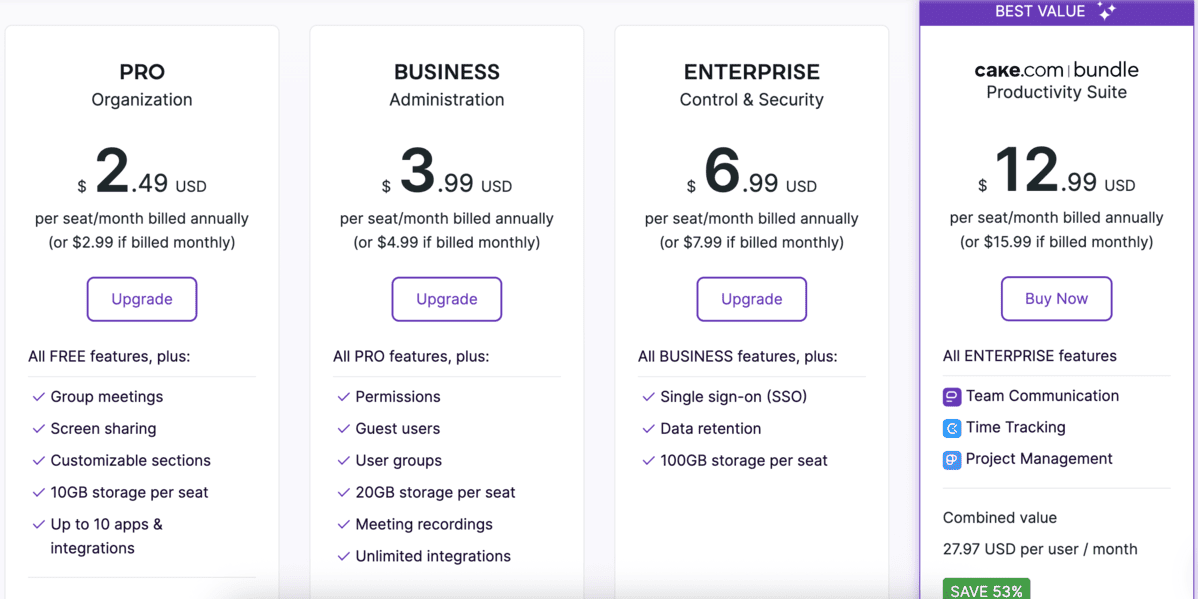
It grows with your team, not against it. Even the PRO plan feels generous, and moving to BUSINESS or ENTERPRISE adds advanced features, without making you feel like basic functionality is being held hostage.
Let’s take a look at Pumble’s paid plans breakdown:
| Plan | Price (per user/month, billed annually) | Key features |
|---|---|---|
| PRO | $2.49 | 10 GB of storage per user; Priority support; Unlimited guests; Message editing; External sharing. |
| BUSINESS | $3.99 | 20 GB of storage per user; Advanced permissions; Google SSO; Data export. |
| ENTERPRISE | $6.99 | 100 GB of storage per user; SAML SSO; Audit logs; Custom SLA; Dedicated CSM. |
What stands out to me is how even the PRO plan feels “complete.” I’m not constantly hitting upsell walls. Need more guests? Got it. Want to edit older messages? Included.
Storage capacity per user is very generous, especially compared to some platforms that still charge extra for history or file limits.
Zoom’s pricing feels a bit more complex and focused mainly on unlocking its video conferencing superpowers, rather than enhancing its messaging capabilities.
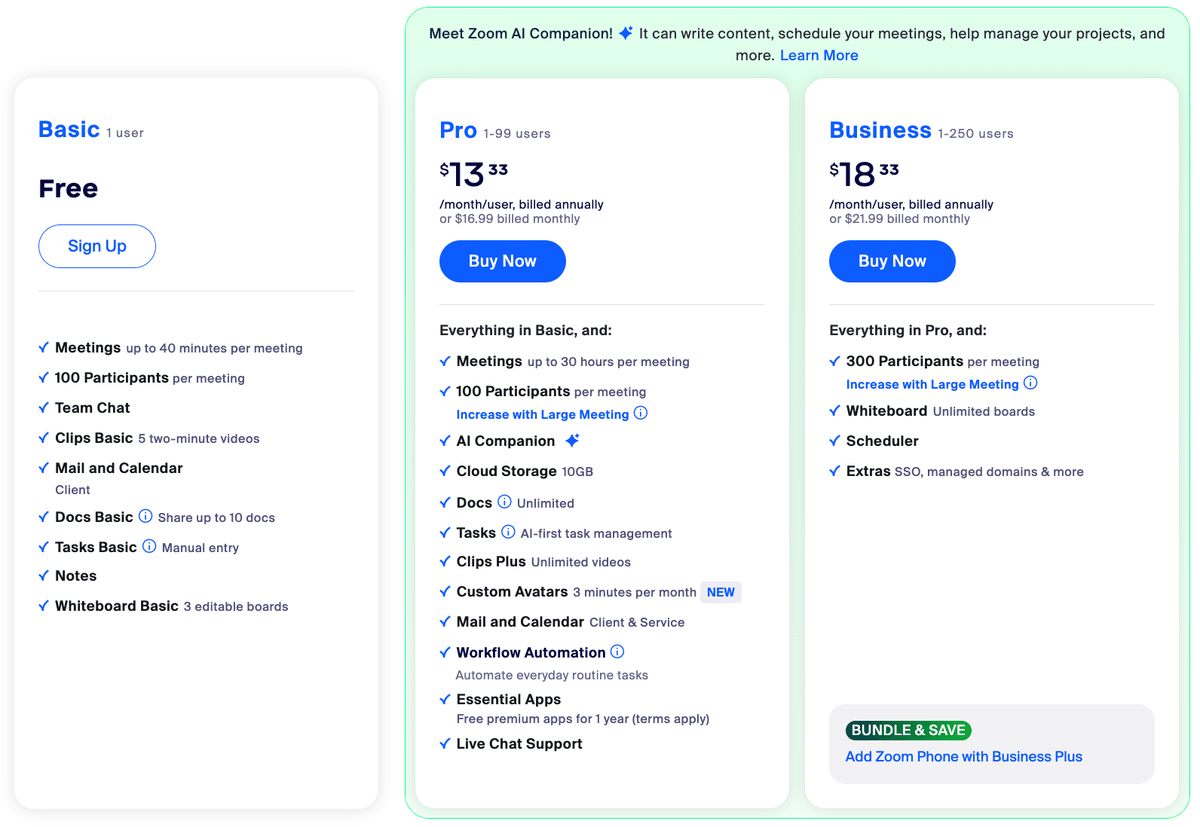
Here’s a more detailed breakdown of Zoom’s pricing plans:
| Plan | Price (per user/month, billed annually) | Key features |
|---|---|---|
| Pro | $13.33 | 30-hour meetings; 100 max participants; 10 GB cloud recording; End-to-end encryption for meetings. |
| Business | $18.33 | 300 max participants; Managed domains; Single sign-on. |
But here’s the catch — Zoom Team Chat doesn’t evolve much as you upgrade. Most of what you’re paying for goes toward meeting features. You get longer sessions, larger groups, cloud recording, and Zoom Phone.
So, if your goal is improving internal communication, you won’t get far with Zoom — you’re basically paying for better meetings while still potentially needing another tool for messaging (like Pumble, for example).
When I weighed the value side-by-side, this is what I saw.
With Pumble, even at $2.49, I get a powerful internal communication hub. It’s enough for the entire team to scale — with channels, threads, guests, search, and storage all covered.
With Zoom, $13.33 unlocks great meeting features, but it doesn’t fix the fragmented internal chat experience that made you seek alternatives in the first place.
It comes down to this question: do you want to pay for better meetings — or better collaboration?
In my experience, the answer is both, but from different tools. I can consider staying on Zoom’s free or Pro plan for webinars, but I’ll always pick Pumble PRO as the place where real collaboration happens.
Pumble vs Zoom: Clean & frictionless UI vs feature overload
Pumble has an interface that just makes sense.
The onboarding is fast, the navigation is intuitive, and everything — from channels to threads — is built to reduce clutter and confusion.
It’s ideal for teams that don’t want to spend hours training employees or digging through menus to find what they need.
To me, using Pumble feels super organized and you can find your way around in no time.
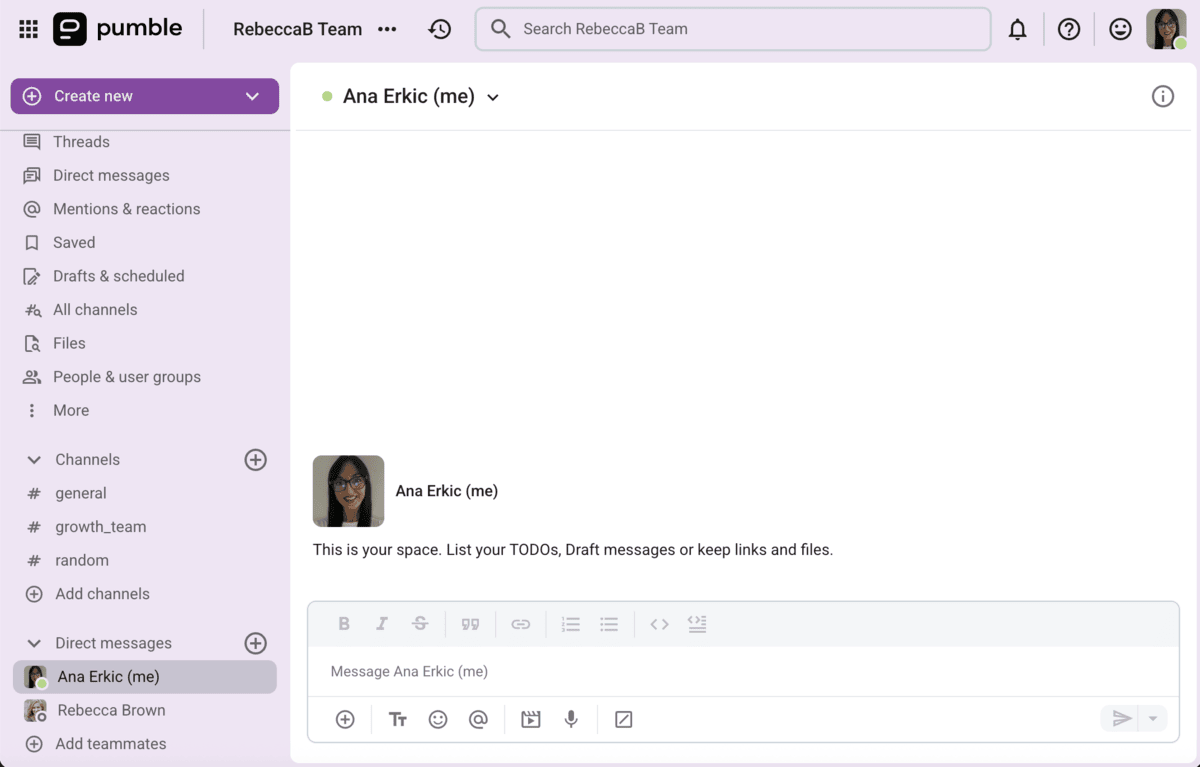
It’s intuitive and easy to use due to the following functionalities:
- Fully customizable sidebar that feels logical and hosts channels, DMs, mentions and reactions, and files.
- Threads, pins, reactions, scheduling messages — all feel like natural extensions, easy to learn, and not hidden.
- No clutter and no overwhelming design choices.
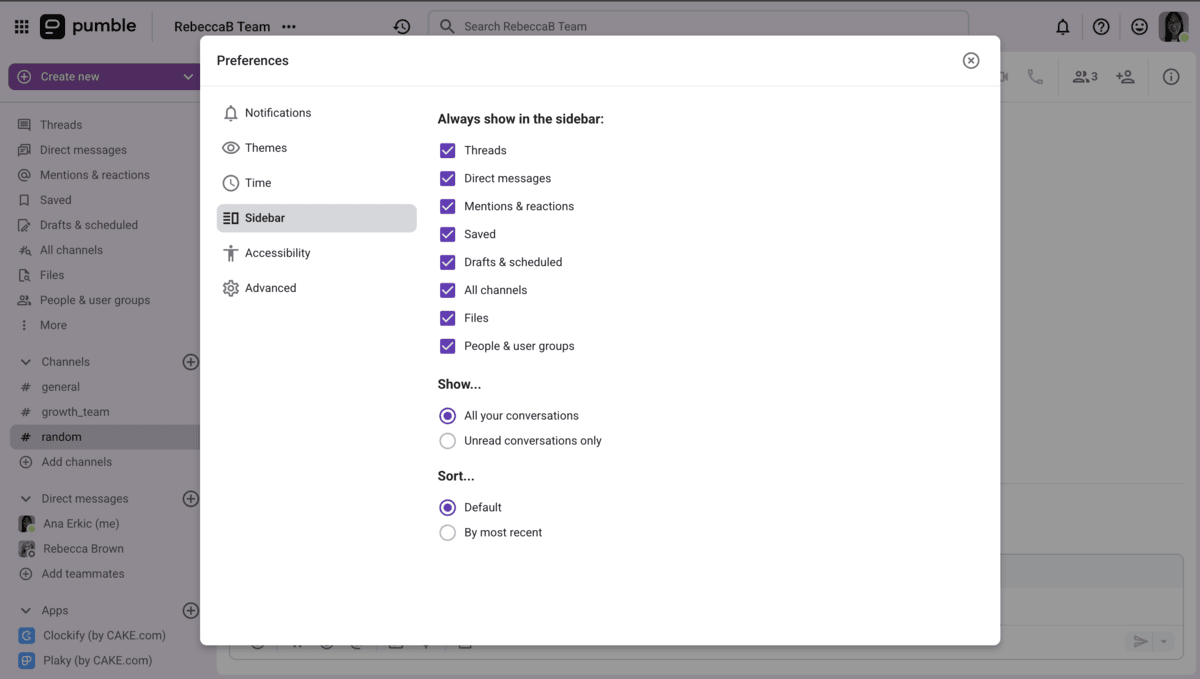
Pumble structures your communication
Even on first use, I found everything without needing onboarding.
In short, Pumble feels like it was built to disappear so you can focus on communicating, not the tool.
Zoom, on the other hand, is complex, although familiar.
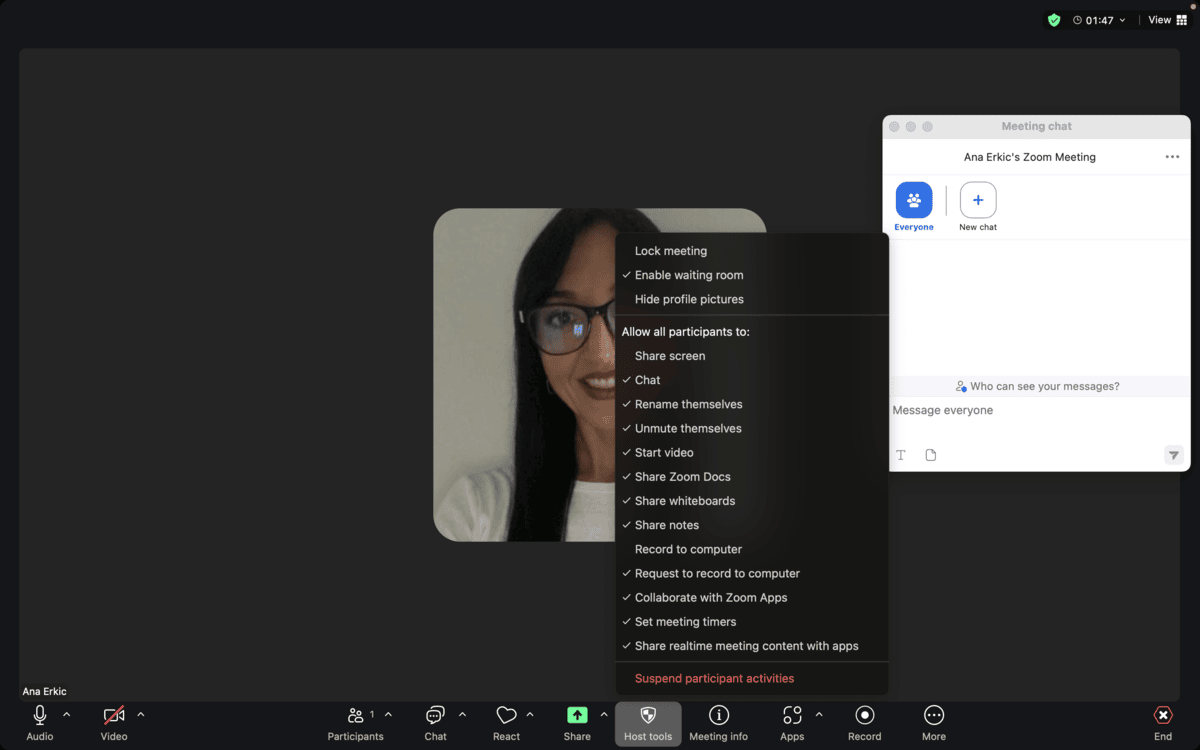
It’s very capable in its own right, but the interface can feel busy, especially as it adds more features beyond meetings. Zoom Team Chat, in particular, can feel like an afterthought, buried behind meeting tabs, making it less obvious to new users.
Basically, I felt like I was using two different apps with two different but very busy interface layouts — one for chats and the other one for meetings. So, trying to navigate different forms of communication felt disconnected and clunky.
Its feature-heavy quality is what makes it particularly overwhelming for me.
In addition to meeting controls, chat, webinars, profiles, admin settings being crammed into the meeting interface, Team Chat is hidden behind the meeting interface. Moreover, as a new user, finding group chat or threads feels unintuitive.
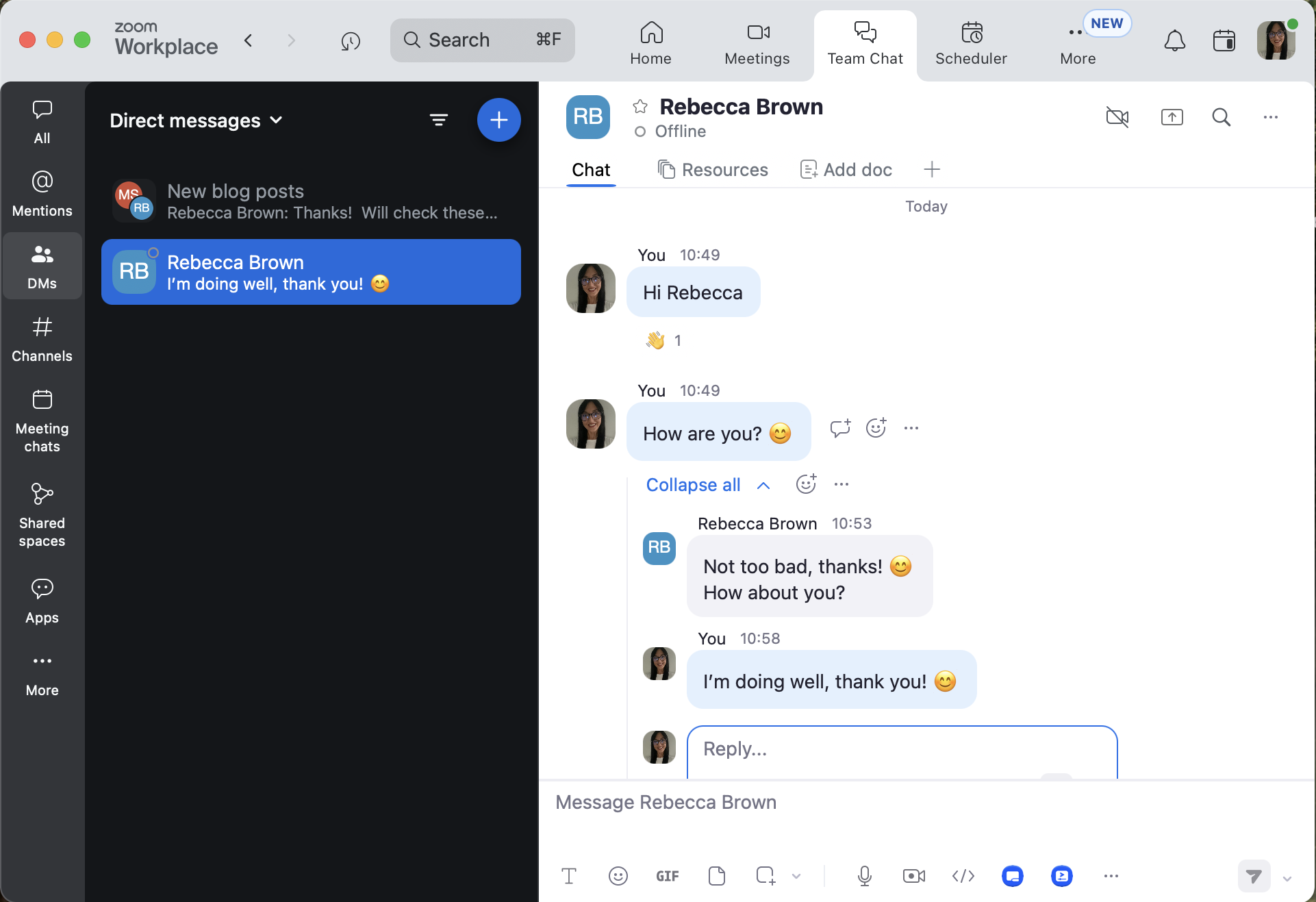
The bottom line is, if you’re looking for a clean, intuitive, and focused communication solution your team can adopt fast with minimum training, Pumble is your obvious choice.
Pumble vs Zoom: Pumble organizes your conversations, while Zoom hides them
One of the first things you’ll notice about Pumble is that it’s designed from the ground up as a business messaging platform.
It features:
- Channels — room for your projects, teams, client communication, or even fun, off-the-record moments.
- Threads — focused discussions to keep context clear so conversations don’t derail the main channel topic.
- DMs — quick 1:1s when you need a private note.
- Unlimited message history, even on the free plan — including search and files — so you never lose any key info.
- 10 GB of storage, free forever.
What I love most about team communication in Pumble is that it feels so intuitive, organized, and comfortable. It’s like arranging your desk drawers where everything has its place.
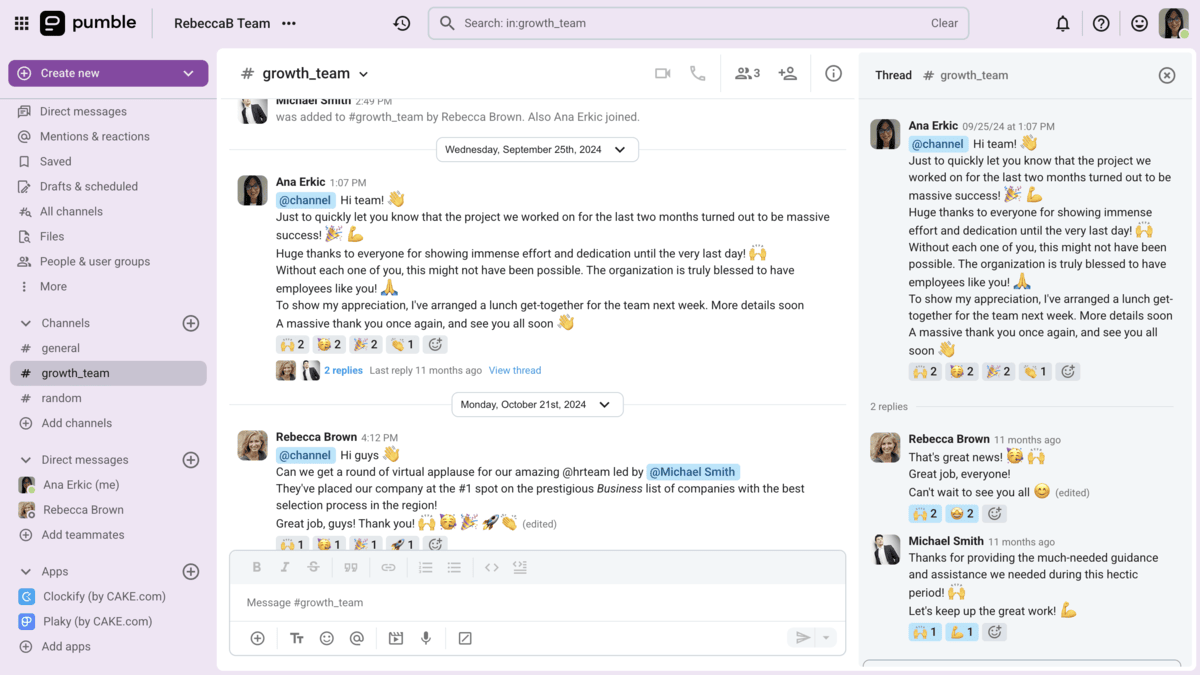
I’ve always been able to search up a decision or link from months ago without having to dig through old emails or meeting transcripts.
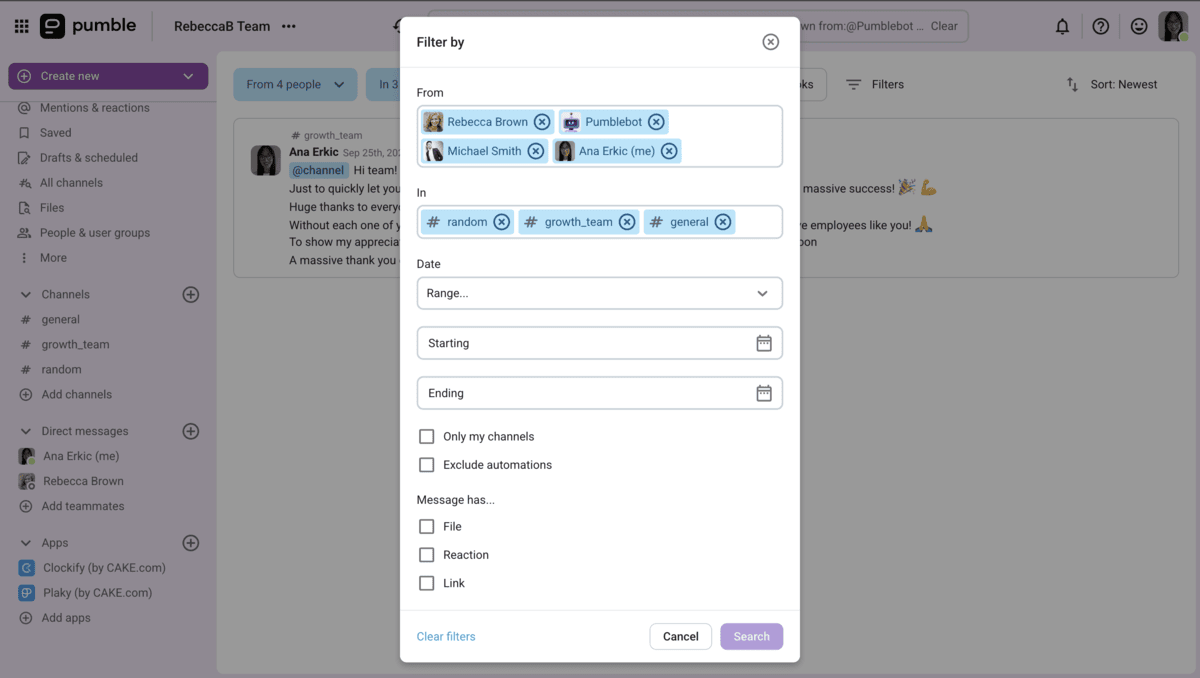
You can search:
- People and user groups,
- Files,
- Messages, and
- Channels.
I had quite the opposite experience with the Zoom Team Chat, which is there, but only if you remember it’s there.
Sure, it offers channels, threads, and DMs, but they are tucked away under the shadow of the meeting interface.
Meeting chats often disappear when you close the window, threads feel clunky, and search is basic, at best. You can only search folders, not the conversations. I often found myself wondering if a piece of information was in chat yesterday or that email last week. That uncertainty is very disruptive in my book.
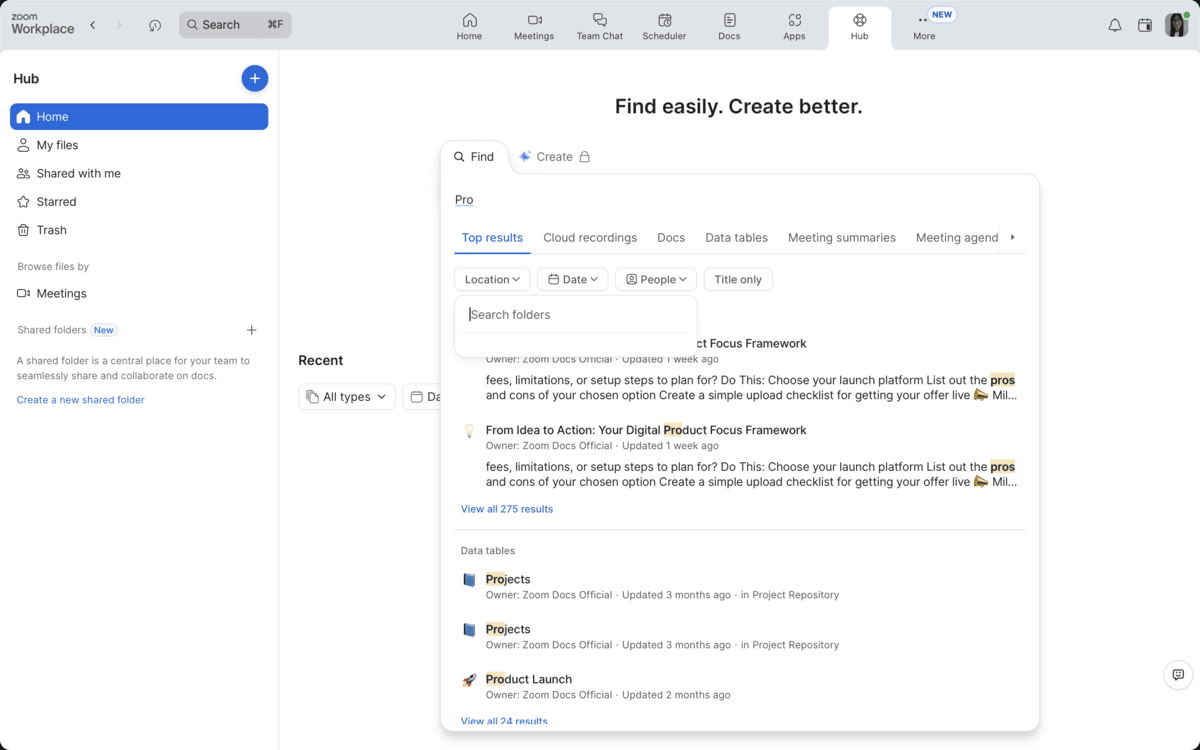
If you’re looking for a sense of a permanent collaboration hub, you won’t find it here.
Zoom Team Chat works if your needs are light, though. But, if you’ve ever lost track of a discussion in the chaos of Zoom meetings, you’ll know what I mean. It can’t replace a tool like Pumble.
Pumble vs Zoom: In Pumble, your guests feel at home, while Zoom keeps them at arm’s length
Another way you can tell Pumble and Zoom have been built with different purposes in mind is if you take a look at how they approach their guest access features.
In Pumble, guest access is seamlessly interwoven with the messaging-first workflow. You can collaborate with partners outside your organization by giving them access to as many channels as you like, and your communication with them is pretty much the same as with the people in your team.
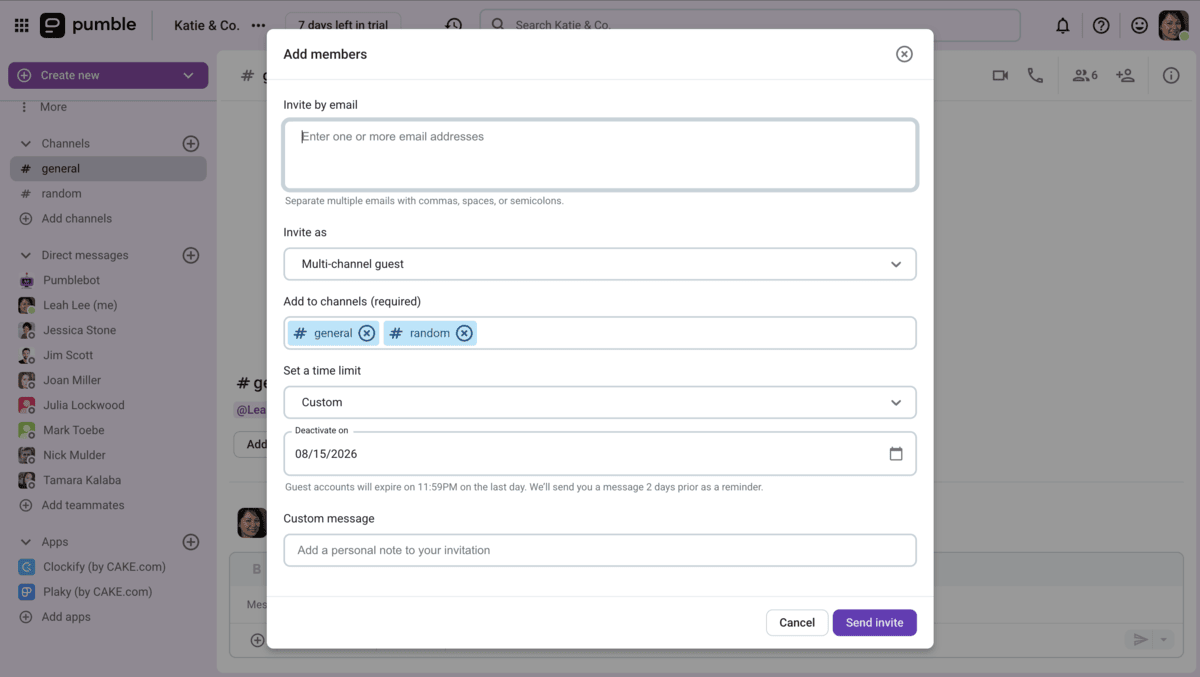
Zoom, as expected, takes a more call-centric approach to external communication.

To communicate with guests in Zoom, you have to send them a link to your meeting, and enable options that grant them the access without signing in to a Zoom account.
Pumble vs Zoom: Pumble has video integrated into its workflow, while Zoom is the industry standard for video conferencing
As expected, the two apps approach video conferencing differently.
Pumble has video integrated into its messaging and collaboration channels, while Zoom has always been identified as a video-first platform.
Pumble supports both voice and video calls, including group calls and screen sharing (even on the Free or PRO plans).
But, by the looks of it, it’s not aiming to become the next Zoom any time soon.
Instead, video is there as an integrated part of the messaging-first workflow. It’s available when you need it, but without dragging your conversations out of context.
It’s perfect for jumping on a quick call with a teammate when messaging isn’t enough to cover your collaboration needs.
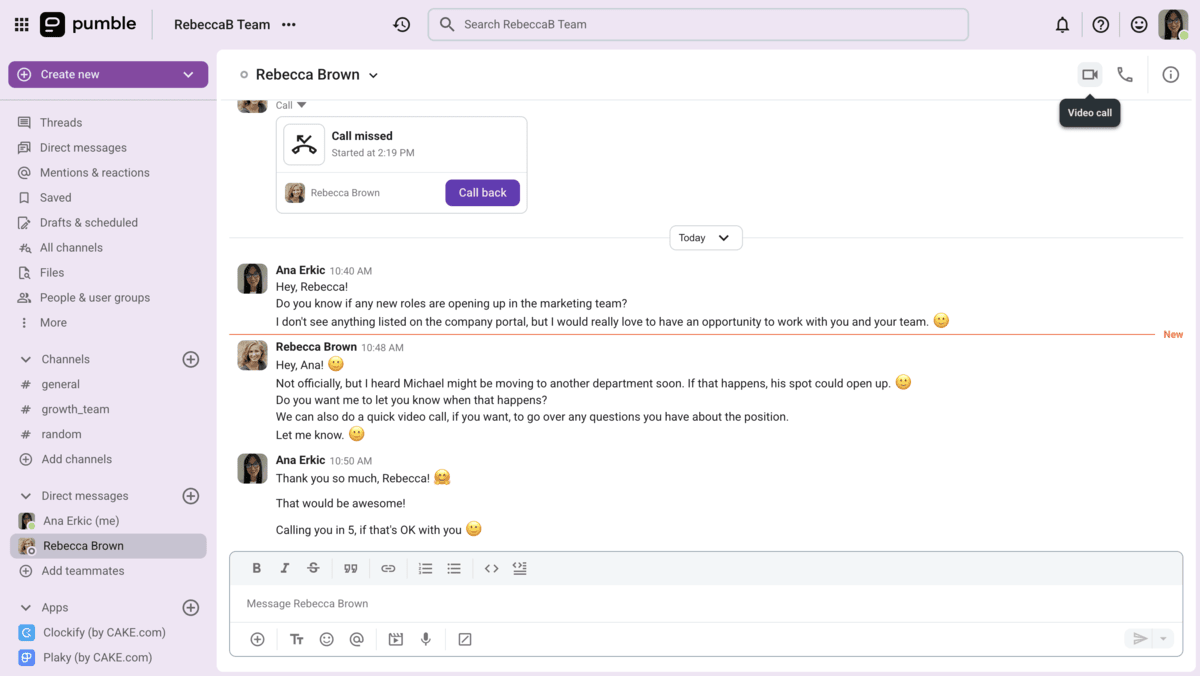
Whenever a conversation is too long or needs clarity, I hit the call button right there in the conversation. It’s simple with 1:1 or group voice or video calls with screen sharing. You can also record these meeting sessions to keep all your important decisions on file.
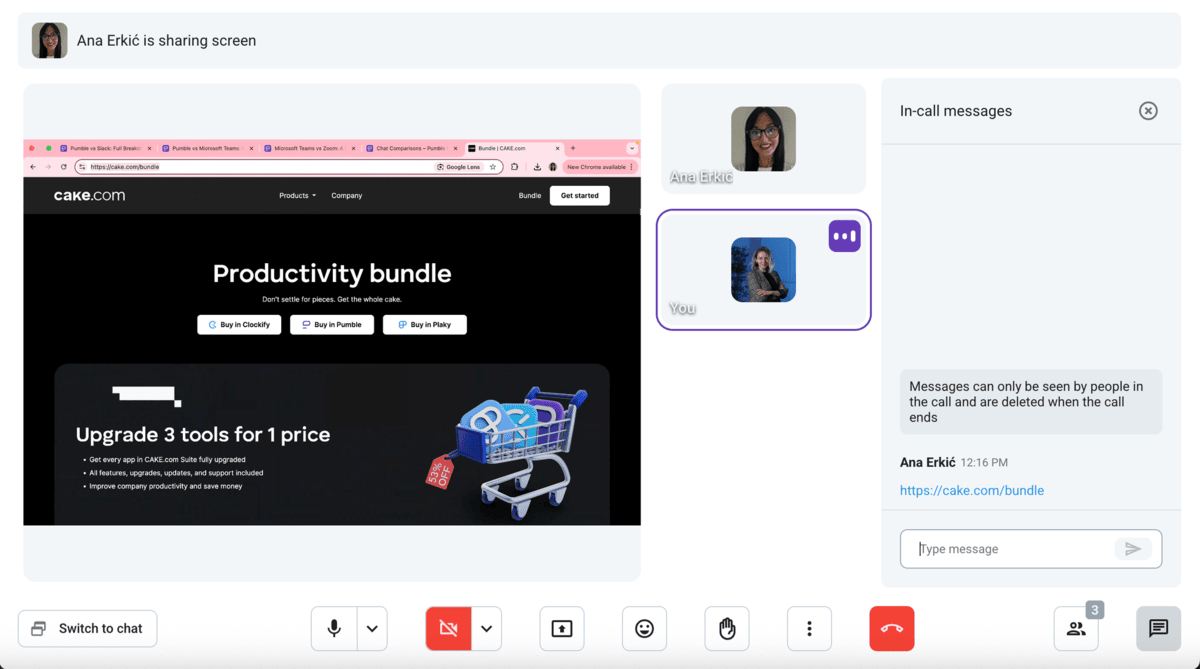
However, I have to give credit where credit is due — Zoom is the gold standard for video conferencing. It still leads for polished, larger-scale video conferencing.
As a specialized video conferencing platform, it offers high-quality video and audio with several levels of noise reduction, which can come in handy when you’re in noisy coworking spaces.
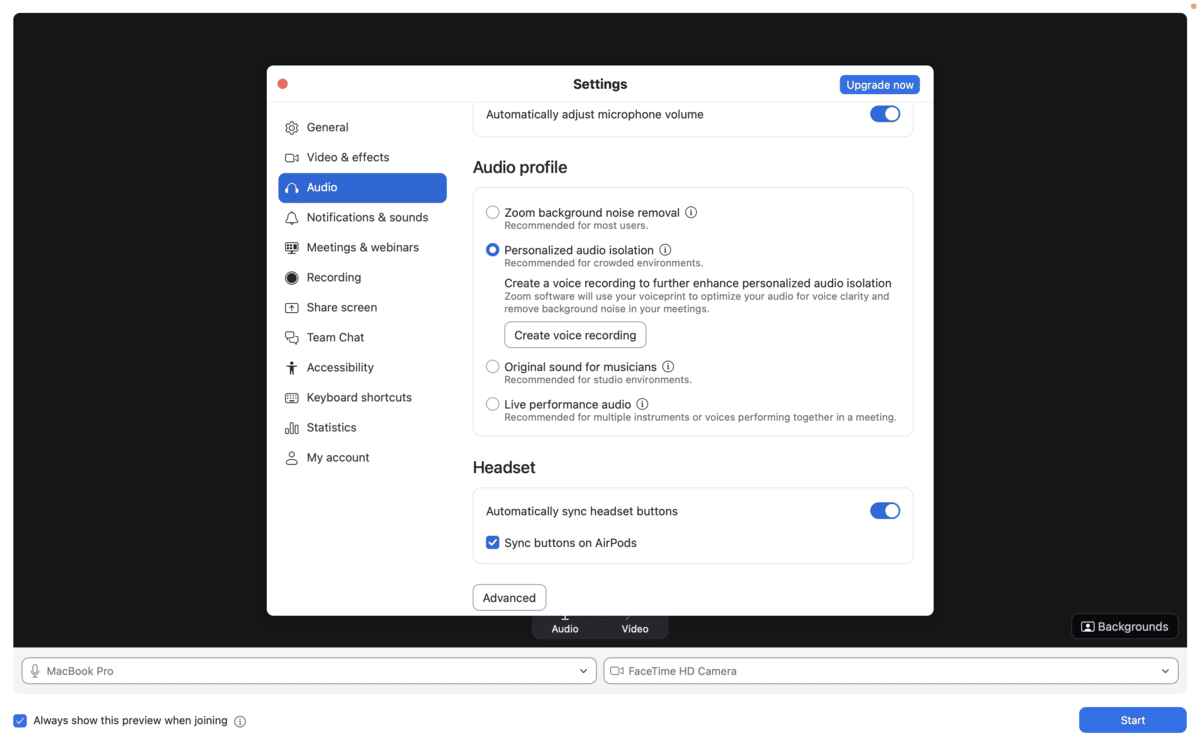
It also has multiple options for video settings such as HD video, a touch up to your appearance, or (a personal favorite) adjustment for low light background. It’s a life-saver when you want to look as professional as possible in meetings, even on gloomy days and in the evenings.
Another plus — your video quality is consistent even on low bandwidth, which is another benefit for when you are remote.
Zoom brings robust meeting features such as breakout rooms, whiteboards, and meeting recording to your:
- External client calls,
- Webinars and virtual events,
- Sales demos, or
- Cross-functional video collaboration.
However, Zoom could work on improving their screen sharing weaknesses. The most annoying one is that, when someone shares their screen, it automatically takes up your entire screen. Or, when you share your screen and use multiple monitors, it can be difficult to find the controls.
The verdict is clear here — Pumble is great when you need to organize calls within your collaboration hub, whereas when your larger meetings need polish and functionality — Zoom is hard to beat.
Pumble vs Zoom: Pumble keeps your archive organized, while Zoom can make your attachments disappear
When you realize Pumble keeps all your files in one place, it’s nothing short of liberating.
All your PDFs, screenshots, and video recordings stay within conversations.
Search works, previews show up inline, and pins keep critical documents at the top. That’s all I want from my digital communication hub.
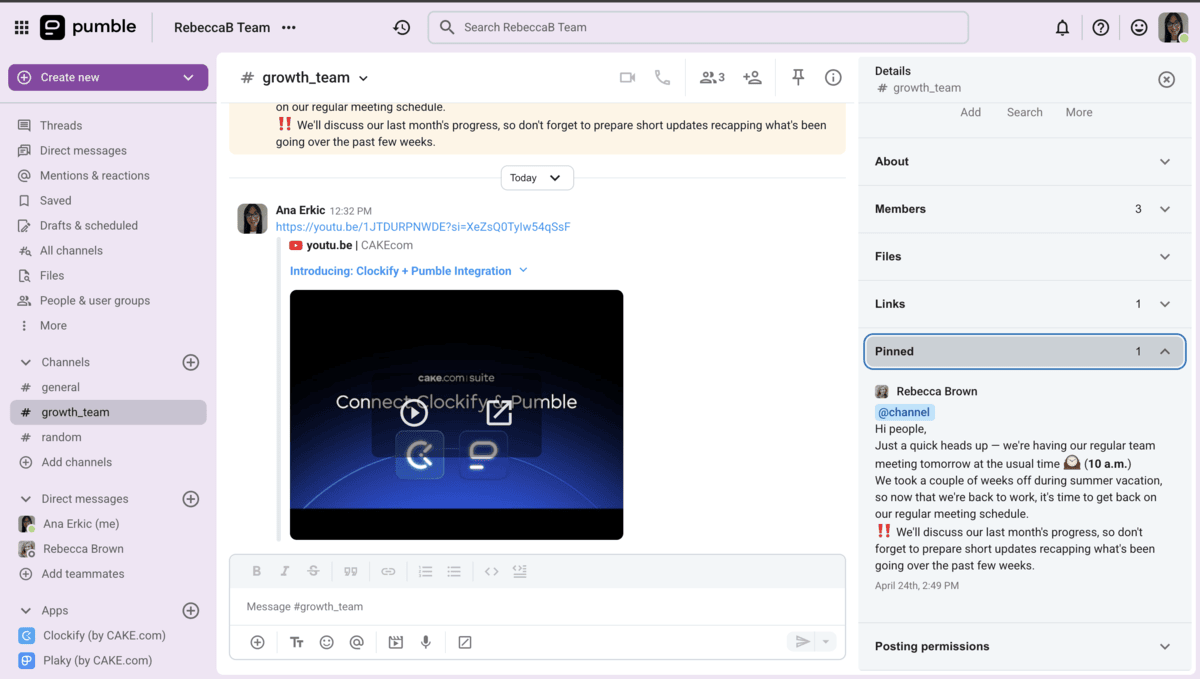
Here’s how storage in Pumble stacks up by plan:
- Free plan: 10 GB shared workspace storage,
- PRO plan: 10 GB per user,
- BUSINESS plan: 20 GB per user,
- ENTERPRISE plan: 100 GB per user.
I’ve never run out of space in Pumble, even with screenshots, meeting recordings, and design assets piling up.
Zoom meeting chats do let you share files in-session, but, once the chat ends or the meeting closes, finding those files becomes a scavenger hunt. It lacks permanence, which is a real dealbreaker, at least for me. I can only save something locally, and there’s no central archive linked to my conversations I can quickly refer back to.

As per cloud storage, Zoom has a limiting offer, to say the least:
- Free plan: No cloud storage,
- Pro plan: 10 GB per license,
- Business plan: 10 GB per license.
So, all things considered, Pumble wins again with a frictionless and reliable place to store and access files.
Keep all your important decisions and resources organized in Pumble
Pumble vs Zoom: Pumble has less integrations, but they are more focused
You can define Pumble’s app ecosystem as lean but strategic.
I appreciate how it doesn’t drown you in app options, but still covers essentials needed to keep your workflow running smoothly.
Built-in integrations in Pumble feel purposeful and painless, and include:
Moreover, Pumble’s integration catalogue is continuously expanding and is soon adding Asana, Trello, and HubSpot to the mix.
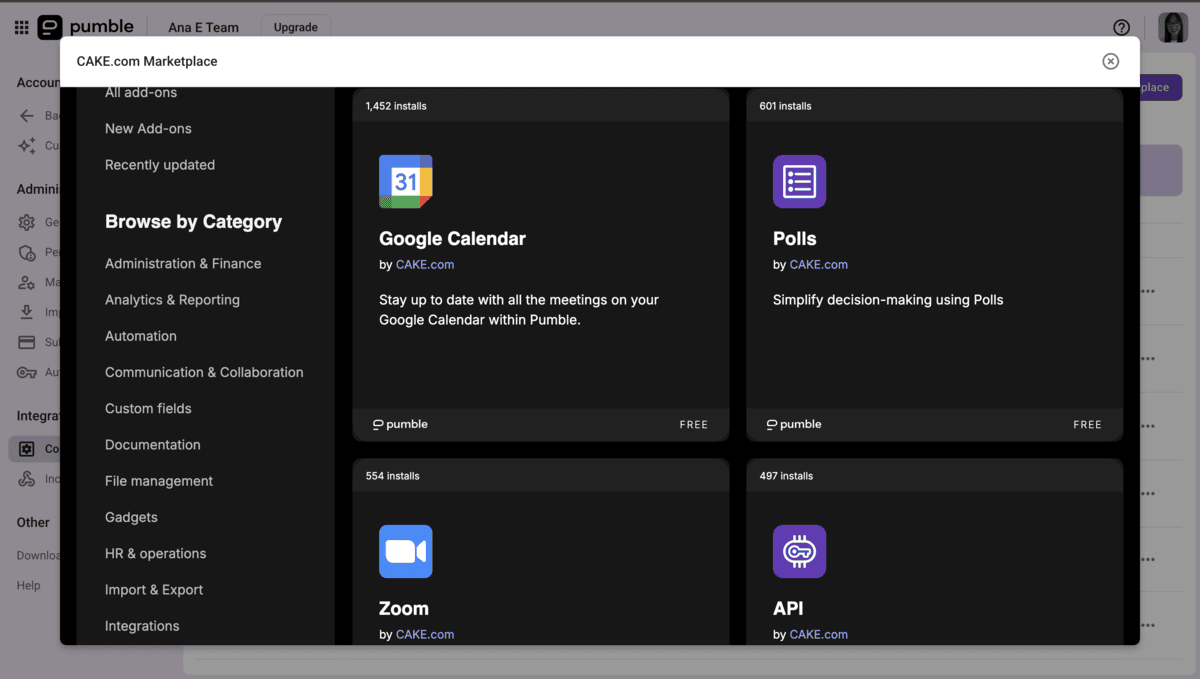
If you need more apps, the CAKE.com marketplace and API let you customize or automate your core workflows. That’s enough to streamline productivity without filling your sidebar with unnecessary icons.
Build your own integrations with Pumble
Zoom integrates solidly with scheduling tools such as Outlook or Google Calendar.
However, its marketplace leans toward enhancing the meeting experience with virtual backgrounds, overlays, and Zoom Apps. You can tell right away that their main focus was not expanding internal communication beyond meetings.
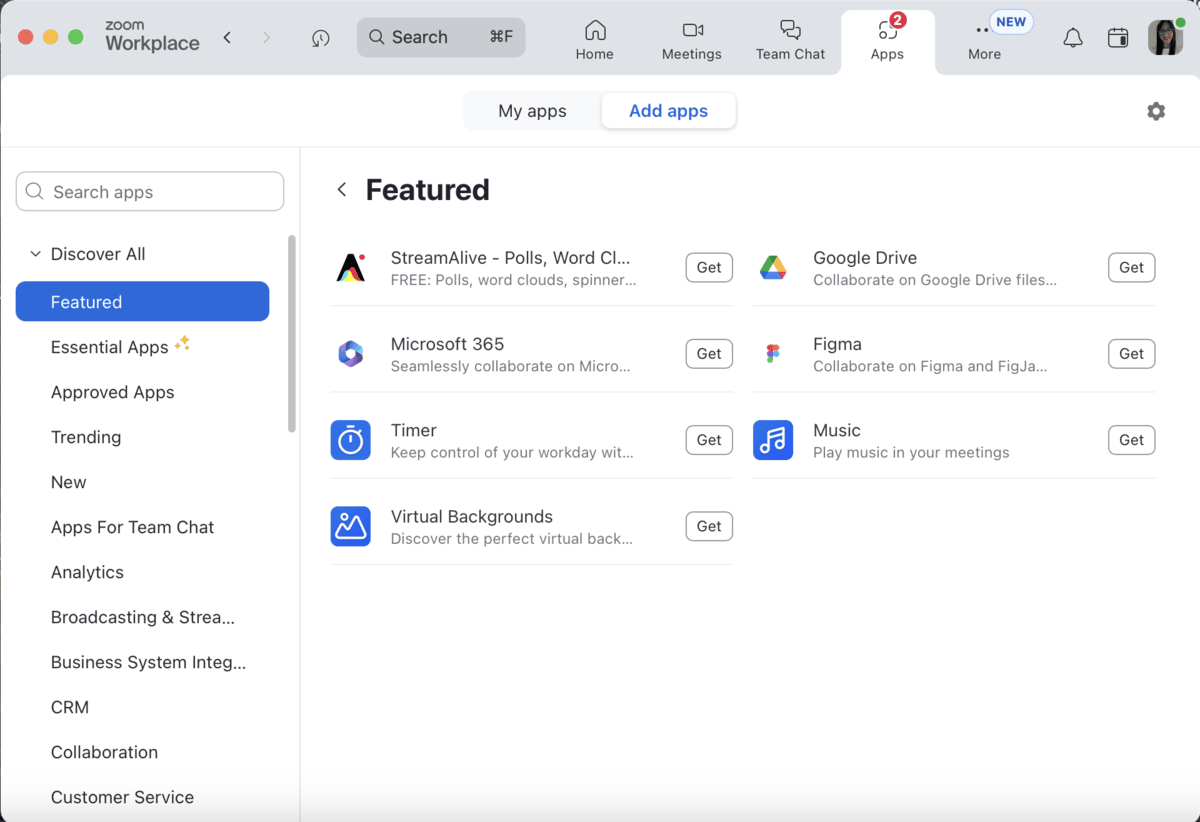
So, although it depends on your particular needs, in my opinion, Pumble takes a clear win for teams that want meaningful integrations, not just more icons.
Pumble vs Zoom: Pumble offers human-centered support
I take support very seriously when assessing the tools I use daily.
Basically, it can make or break your workflow. Just imagine how much it can derail your plans if you’re left waiting for days on an answer about an issue you’ve encountered.
Pumble is well-known for its around-the-clock, human support.
So, while I tested the apps, I put in a question late one evening. And, as expected, I got a reply before morning — friendly, human, and direct.
That’s thanks to Pumble’s 24/7 support and 99.99% uptime SLA available even on ENTERPRISE level, which is generally more difficult to achieve on enterprise level than for lower-tier plans.
There are several ways you can contact Pumble support:
- Email,
- Chatbot,
- Phone, or
- Contact form.
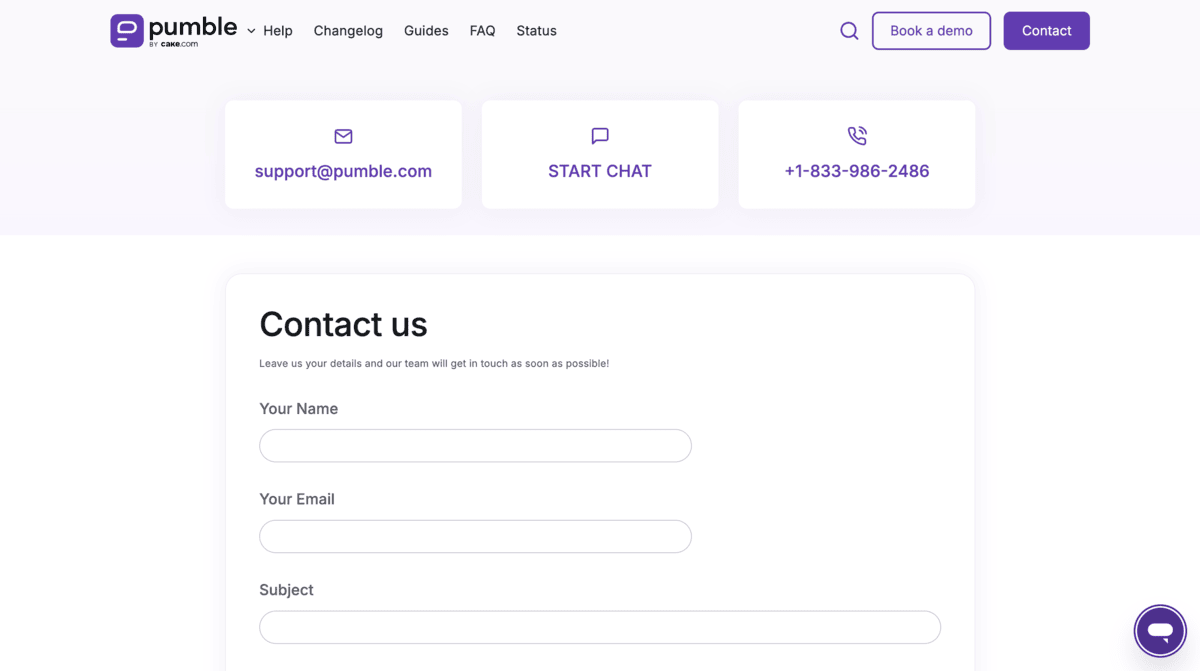
That’s around-the-clock availability even on the FREE plan.
Upgrading to paid plans gets you a dedicated customer success representative who takes care of your workspace needs as your business scales.
Experience award-winning customer support with Pumble
Zoom offers the following resources in their knowledge library:
- Help Center,
- FAQ,
- Live training,
- Blog, and
- How-to videos.
However, unlike Pumble, Zoom will only let you get the Help Center resources for free.
Consistent with their entire billing philosophy, Zoom gives you the number of support options you’re willing to pay for. If you’re on the Pro plan, you get the 24/7 support via ticket and live chat support. Only BUSINESS plan users get the additional phone support.
Pumble vs Zoom: Pumble historically takes security more seriously
Security-wise, Pumble makes me feel more in control.
I don’t worry about unwanted attendees crashing my meetings, or data vanishing or leaking, thanks to:
- Control over data retention,
- SSO options,
- Roles and permissions for admins,
- Data encryption, and
- Multi-factor authentication.
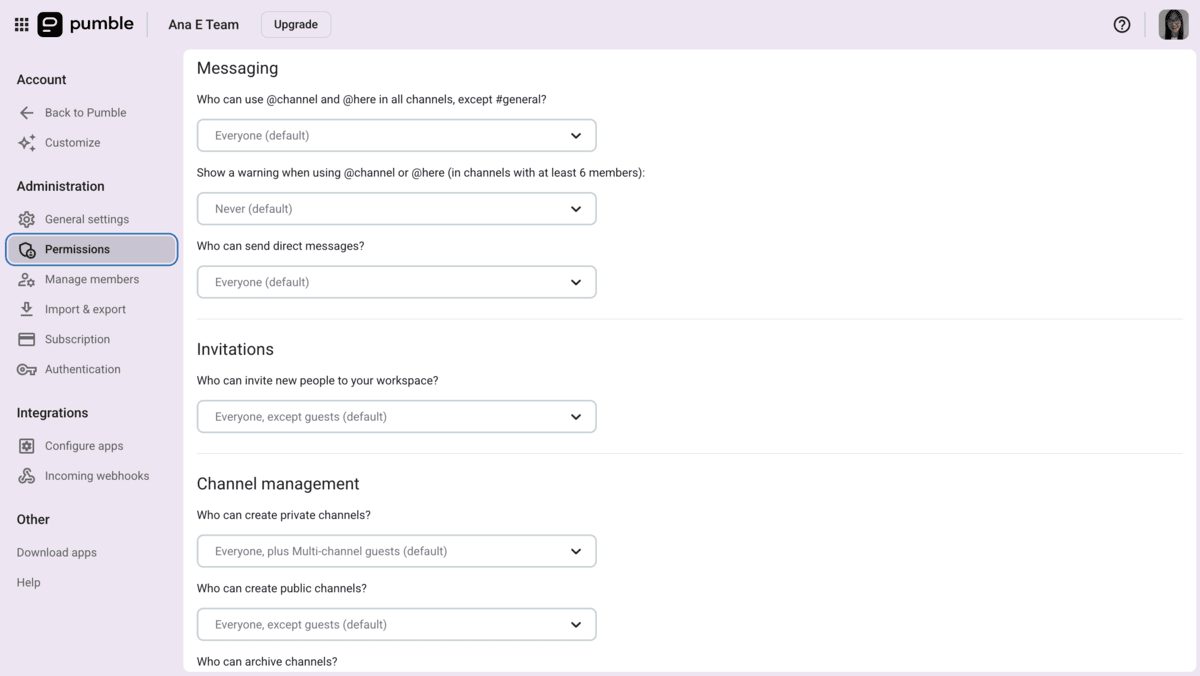
Moreover, Pumble follows strict protocols for information security, risk management, and data privacy. It’s certified for ISO/IEC 27001:2022 and SOC 2.
Conversely, Zoom still can’t shake off its poor security reputation involving Zoombombing and encryption algorithm vulnerability.
It has done everything to step up its security game, including adding:
- AES-256 encryption,
- Meeting passwords,
- Waiting rooms, and
- End-to-end encryption on selected plans.

So, basically, Zoom is technically secure, but bundled in complexity. Its security looks solid, but setting up all that securely takes effort, especially for internal conversations, which aren’t its core focus.
If you want polished security and control, I’d go with Pumble any time. It gives you what you need without extra complexity. It’s more focused on internal usage, which makes it more transparent and easier to manage.
Pumble is best for organized internal communication
If external meetings are critical for your business, meaning you’re a client-facing business and are hosting webinars or doing polished larger events on the regular, Zoom is your go-to. However, consider you’ll probably need another IM service on the side. So, you’ll have to pay twice.
On the other hand, if your internal team thrives on structured, dependable conversation, where files stay connected to context, threads are kept intact, and everything is searchable, Pumble brings the order your workflow needs.
Pro-tip I have: try to run them side-by-side to see what works best for your team. You can use Pumble for internal collaboration and connect Zoom to join webinars and manage larger meetings from one place.
This way, your team gets the best of both worlds — structured, searchable communication and meeting capacity you need.
By the end of this experiment, you’ll be able to make a well-informed decision that aligns with your realistic needs and the apps’ strongest suits.
Want to experience streamlined and safe communication and productive teamwork?

